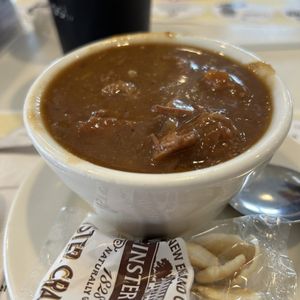India-Myanmar Food Festival: A Culinary Bridge

Table of Contents
A Fusion of Flavors: Shared Culinary Heritage
The India-Myanmar Food Festival isn't just about delicious food; it's a testament to the intertwined culinary histories of India and Myanmar. Centuries of interaction have resulted in surprising similarities and fascinating influences between these two distinct cuisines.
Common Ingredients: The Foundation of Flavor
Both Indian and Myanmar cuisines share a remarkable number of staple ingredients, forming the bedrock of their diverse dishes.
- Rice: The cornerstone of both diets, rice appears in countless variations – from fragrant basmati in Indian dishes to the glutinous rice used in many Myanmar recipes. The versatility of rice makes it a key ingredient in everything from simple side dishes to elaborate feasts at the India-Myanmar Food Festival.
- Spices: The aromatic heart of both cuisines beats with a shared love of spices. Turmeric, chili, ginger, and garlic are prevalent, though their applications and flavor profiles differ subtly. Indian cuisine often features complex spice blends, while Myanmar cuisine employs spices with a more pronounced freshness.
- Legumes: Lentils, beans, and chickpeas are essential protein sources in both culinary traditions. From the hearty daals of India to the flavorful legume-based curries of Myanmar, these ingredients contribute to the nutritional richness of the food on offer at the India-Myanmar Food Festival.
Influences and Exchanges: A Culinary Tapestry
The culinary similarities between India and Myanmar are not accidental; they are the result of centuries of interaction.
- Ancient Trade Routes: The ancient Silk Road and other trade routes facilitated the exchange of not only goods but also recipes and culinary techniques between India and Myanmar. The flow of ingredients and ideas across these routes significantly shaped the development of both cuisines.
- Colonial Influences: British colonization left its mark on both countries, introducing certain ingredients and culinary practices. While the impact varied, the legacy of this period is visible in specific dishes and cooking methods found at the India-Myanmar Food Festival.
- Modern Collaborations: Today, chefs from both countries are actively engaging in cross-cultural collaborations, creating innovative fusion dishes that celebrate the best of both worlds. These modern culinary dialogues are a highlight of the India-Myanmar Food Festival, showcasing the exciting potential for future culinary exchanges.
Must-Try Dishes at the India-Myanmar Food Festival
The India-Myanmar Food Festival offers a mouthwatering array of dishes, a true testament to the richness of both culinary traditions. Here are some must-try options:
Myanmar Delights: A Taste of the Golden Land
- Tea Leaf Salad (Lahpet Thoke): This unique salad, a national favorite, features fermented tea leaves mixed with crunchy peanuts, beans, sesame seeds, and a variety of other ingredients. It's a complex and surprisingly addictive dish.
- Mohinga: Considered Myanmar's national dish, Mohinga is a flavorful fish noodle soup, typically seasoned with lemongrass, ginger, garlic, and shrimp paste. Its rich broth and delicate flavors are a true representation of Myanmar's culinary soul.
- Ohno Khauk Swe: This popular noodle soup features coconut milk, turmeric, and often includes chicken or beef. It offers a rich and creamy taste that perfectly complements the other dishes at the India-Myanmar Food Festival.
Indian Specialties: A Journey Through Regional Flavors
India's culinary landscape is incredibly diverse, and the India-Myanmar Food Festival aims to showcase this variety.
- Selection of Curries: Expect a wide selection of curries, reflecting the vast regional variations found across India. From the creamy butter chicken to the spicy vindaloo, each curry offers a unique flavor profile.
- Naan and Roti: These popular flatbreads are essential accompaniments to many Indian dishes. Their soft texture and slightly charred flavor make them a perfect complement to the rich curries and other dishes.
- Sweets and Desserts: Indulge in the sweetness of traditional Indian desserts like gulab jamun (deep-fried milk balls in sugar syrup) or jalebi (crispy, deep-fried spirals).
Fusion Creations: Blending Two Culinary Worlds
One of the most exciting aspects of the India-Myanmar Food Festival is the opportunity to sample innovative fusion dishes. Expect to find creative combinations that blend the best of Indian and Myanmar flavors, showcasing the potential for exciting culinary cross-pollination. These unique creations often incorporate traditional ingredients in unexpected ways, resulting in a truly unforgettable culinary experience.
Beyond the Food: Cultural Immersion at the Festival
The India-Myanmar Food Festival is more than just a food event; it's a celebration of culture and community.
Cultural Performances: A Symphony of Sounds and Sights
Immerse yourself in the vibrant culture of India and Myanmar through traditional dances, music, and artistic performances. These performances offer a glimpse into the rich artistic heritage of both countries.
Craft and Artisan Stalls: Treasures to Take Home
Explore a wide array of handcrafted items from both India and Myanmar. These stalls offer a unique opportunity to purchase souvenirs and support local artisans.
Community Engagement: A Bridge of Understanding
The India-Myanmar Food Festival fosters a sense of community and understanding. It is a platform for cultural exchange and interaction, providing an opportunity to learn about the diverse cultures of India and Myanmar in a fun and engaging setting.
Conclusion: A Culinary Journey Awaits
The India-Myanmar Food Festival offers a unique opportunity to explore a fascinating culinary bridge between two vibrant cultures. By experiencing the shared ingredients, distinct flavors, and the rich cultural tapestry woven into each dish, attendees gain a deeper appreciation for the culinary heritage of both India and Myanmar. Don't miss the chance to be a part of this enriching gastronomic adventure. Plan your visit to the India-Myanmar Food Festival and savor the unforgettable flavors awaiting you! Discover the unique blend of India-Myanmar cuisine and experience the culinary bridge firsthand!

Featured Posts
-
 Brexits Gibraltar Problem Talks Remain Stalled
May 13, 2025
Brexits Gibraltar Problem Talks Remain Stalled
May 13, 2025 -
 8 0 Persipura Jayapura Bungkam Rans Fc Di Playoff Liga 2
May 13, 2025
8 0 Persipura Jayapura Bungkam Rans Fc Di Playoff Liga 2
May 13, 2025 -
 A Critical Look At Flushed Away Strengths And Weaknesses
May 13, 2025
A Critical Look At Flushed Away Strengths And Weaknesses
May 13, 2025 -
 Accord Post Brexit Gibraltar Les Dernieres Nouvelles
May 13, 2025
Accord Post Brexit Gibraltar Les Dernieres Nouvelles
May 13, 2025 -
 Heatwave Warning Centre Urges States To Take Precautions
May 13, 2025
Heatwave Warning Centre Urges States To Take Precautions
May 13, 2025
Latest Posts
-
 Watch Eva Longoria Searching For Spain Streaming Guide
May 13, 2025
Watch Eva Longoria Searching For Spain Streaming Guide
May 13, 2025 -
 Where To Stream Eva Longorias Searching For Spain
May 13, 2025
Where To Stream Eva Longorias Searching For Spain
May 13, 2025 -
 Eva Longorias Travel Series Gets Release Date Watch The Trailer
May 13, 2025
Eva Longorias Travel Series Gets Release Date Watch The Trailer
May 13, 2025 -
 Eva Longorias Hair Makeover The Photos You Need To See
May 13, 2025
Eva Longorias Hair Makeover The Photos You Need To See
May 13, 2025 -
 A Look At Eva Longorias 50th Birthday Fiesta In Miami
May 13, 2025
A Look At Eva Longorias 50th Birthday Fiesta In Miami
May 13, 2025
